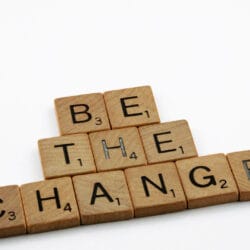What does it take to think like a futurist? What is a disruptor? What techniques…
What is applied knowledge and why it can help you (and an entire country) innovate and problem-solve better?!
This article is from our new ‘how to solve problems’ series, where we introduce some inspiring techniques that help you problem-solve better, such as the applied knowledge technique.
When we were in school we generally had a set curriculum and routine-based lessons. This helped us organize many different types of lessons throughout the day, and helped ensure both parents and teachers knew where to be and when, but did this structure really help us put what we learned to use?
Too often, the ways in which we were taught in curriculums didn’t translate to the knowledge we could then apply to real-life situations, or at least we were never really taught that vital skill in school (see why creativity is important in school and how it is stifled). Even beyond school many of us continue this routined-structure in our jobs and still to this day might not really know how to apply the knowledge we learn.
We might accumulate LOTS of knowledge these days with a world of information at our fingertips, but a large majority of it is either useless or just locked away for a rainy day (but not utilized).
Most of us have heard of the Pareto Principle (the 80-20 rule), and we often apply that rule to tasks we think we need to do that will help the end result, but seldom do we think about how much time and energy is wasted accumulating knowledge we then don’t even use after.
While that could be a topic for a later article, here we focus on actually utilizing the knowledge we do acquire, and why we should.
What Is Applied Knowledge?

Definition: Applied knowledge is ‘learning used in various situations with different tools and techniques to solve diverse problems, issues, and situations’. Applied knowledge means to actively put into practice accumulated knowledge to form and generalize concepts.
In other words, you use your knowledge as a source to use in multiple areas rather than just one. You might have transferable skills, but you also have transferable knowledge that you can pick and choose for the right situation.
This is a skill though in itself as we usually haven’t been taught how to apply knowledge in different ways, other than the initial subject it was directly related to.
How Applied Knowledge Is Used Successfully
When it comes to applied knowledge in action, it may be easier to look at an example of a huge success story.
A whole country has adopted this approach for many years and seen their economy transform from barely existent 50-60 years ago, to develop into one of the most innovative countries in the world today.
South Korea is a prime example of using applied knowledge well. There’s a whole history as to why this came about. You can read about South Korea’s innovation success story on Nature.
To summarize quickly, initial family companies were subsidized and protected by the government in the 1960s. Why? The government pushed these growing ‘Chaebols’ to invest heavily in R&D while shielding them from competition. Over time this huge emphasis on research and development paid off as companies such as Samsung, LG, Lotte and Hyundai were encouraged to diversify into different growing areas, namely information products, using applied knowledge to help them grow faster.
“Learning used in various situations with different tools and techniques to solve diverse problems, issues, and situations”
Applied Knowledge meaning
You may think of Samsung as an electronics maker outside of South Korea, but it much bigger and more diverse than that, as it also covers insurance, construction, shipbuilding and more.
How did companies like this grow into different industries so well? Other than collective Chaebol people power (anyone who graduates highly seeks a position in one of these Chaebols) and heavy research and development support, it is the process of applied knowledge and logical reasoning that makes South Korea so good at innovation today.
NOTE: Richly founder Rich Williams lived in South Korea for a number of years and has a lot of respect for the country. See why with 10 Life Lessons Learnt In South Korea and 8 Amazing Ahead Of Time Innovations In South Korea.
It’s also why medicine has been transforming the world so fast, especially in the times of Covid-19 where urgency was ramped up. Through utilizing applied knowledge people from different cultures, career backgrounds, and knowledge spheres were able to come together to create solutions to diverse problems.
Okay, so this is talking about when big companies come together, but what about people as individuals? How can people learn themselves to utilize applied knowledge without having to be part of a huge workforce to see its results compounded?
It’s safe to say that it’s easier to apply knowledge when we are forced to work environments and working in teams on the same problems.
What about us individually though? We often read books, do courses, join webinars, find information through search or social media quickly, but what about applying the knowledge. How can we shift from the passive mode to the active mode?
Well, this is actually one of The 15 Greatest Social Challenges Of Our Modern Time, passive learning, so it’s surely something we should seek to fix, right?
The Applied Knowledge 5-Step Technique/Method. Put Knowledge Into Action

So, here’s the fix. A 5-part technique to try each time you are struggling to apply knowledge, or are just stuck in passive mode accumulating knowledge you assume is the same as making progress.
STEP 1: ASK YOURSELF DIFFERENT QUESTIONS
Before anything else consider the knowledge or skill you are attempting to learn. Are you just watching or reading something mindlessly? Sometimes we do just want to switch off after a hard day, but are we doing this as a habit?
If so, we need to shake our brain into diverse actions. Set yourself notifications to remind you to be mindful and active in your learning if it helps.
Start by asking these questions:
Do I need to learn this? If so, how can this knowledge be used somewhere else other than the subject I’m studying? What would someone else think from a different background and perspective?
Shaking our biases and general comfort is needed in learning. We don’t do it enough. We often find comfortable cafes to relax and feel professional rather than really challenging ourselves to think outside the box by pushing our buttons in the right way to think differently.
STEP 2: IMPLEMENT IT NOW
After asking ourselves questions we should automatically enter ‘active mode’. Now is the best time to implement the knowledge we just learned. Although for applied knowledge to truly be beneficial and cement itself in our memories for later use elsewhere we have to challenge it from the off.
So, instead of just brushing your teeth because you read an article about how you need to brush your teeth more, see how you can apply the principle of hygiene to other areas of your life. This may sound simple, but it’s just a simple example.
You see, an airplane isn’t just one idea, it’s the build-up of many ideas connected together. The wings were inspired from someone learning how birds fly. The Mongol longbow inspired the solutions to deal with plane g-force through understanding the composite of taking two materials of useful properties and putting them together to make something better.
When we implement something now we don’t just cement our learning into our minds, we also make connections with other past learnings and can find new ideas that help us cement our knowledge further.
Take action by incorporating your knowledge into your life. When you implement a concept you’ve learned into your daily life it becomes a part of it rather than is lost in the abyss of other thoughts and learnings than you didn’t implement.
STEP 3) TAKE A DIFFERENT FIRST STEP
We may be tempted to implement what we are learning in a safe and structured way, the way we know how, but we should also consider taking a different first step.
A good way to do this is to ‘mimic’ or ‘act’ like we know what we are doing already. We might not feel comfortable with it but the more we act in different ways the easier it becomes to go beyond our limiting comfort zone.
Often life calls for new and different ways of thinking, so if we only practice the same method all the time then we get in trouble some point down the line. As we gain experience we are in danger of following the comfortable too often, so this step is especially useful for those stuck in fixed routines for a long time.
It’s important to put something new into practice at some point through your day. New or different is good for utilizing applied knowledge more easily because you are forced to focus deeper on something new than something you already know.
STEP 4) GET OTHERS INVOLVED
It’s easier to apply knowledge when you talk about it and let it stick. A student can fast become a teacher by talking out loud to a friend about a concept they just learned. A friend may have another perspective too which can push your thinking further.
Also, don’t be afraid to ask others for motivation to help you if you are stuck, as we don’t know everything. We always learn from each other and we shouldn’t forget that.
Some of the most successful people all had mentors or role models to look up to or aspire to be like. You can do the same. As for applied knowledge, if you had a friend or mentor quiz you on a recent subject then I imagine you would succeed in it far more than if left to your own devices all the time.
STEP 5) FAIL AND REPEAT WITH VARIATION
We often think we need to repeat the same things over and over again to create routines, but this is actually just our defensive mechanisms talking to supposedly keep us safe (to survive). Avoiding change is avoiding danger, so as soon as something new is learnt our brain wants to repeat over and over the same knowledge until it sticks.
The problem with that is it we do end up in routines to the point where we get stuck in a comfort zone again and fear develops again and we don’t do anything new or changed (see The Ultimate Guide To Stepping Out Your Comfort Zone).
For applied knowledge to be useful we need to get used to applying our knowledge to different situations. The best part is to learn to fail, and to be comfortable getting uncomfortable.
A good place to start is to put ourselves in a position of scrutiny. To develop a thicker skin we have to be open to criticism. This doesn’t mean being nasty to others but it doesn’t mean being overly sensitive either (which today’s society arguably is – often because people fear change too much).
To overcome the fear we have to embrace failure. Drop our egos, and learn to persevere.
This isn’t just mindless perseverance though. It’s not about hitting a golf ball a thousand times without thinking and assuming you will improve because you have played more. The practice makes perfect motto only works if we consider deliberate practice.
This article is from our new ‘how to solve problems’ series, where we introduce some inspiring techniques that help you problem-solve better.









